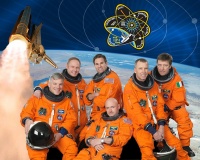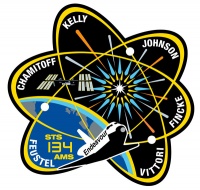STS-134
From The Space Library
 | |
| Organization | National Aeronautics and Space Administration (UnitedStates) |
|---|---|
| Mission type | Human Crew,Resupply/Refurbishment/Repair |
| Launch date | May 16, 2011 |
| Launch vehicle | Space Shuttle |
| Launch site | Cape Canaveral, United States |
| COSPAR ID | 2011-020A |
| Inclination | 51.6 degrees |
| Experiments | Here |
| Alternate Names | 37577 |
| Additional Information | Here |
| Data Collection | Here |
| Payload Mass Up | 13322 kg |
| Payload Mass Down | 1087.73 kg |
| Orbiter | Endeavour |
| Lift Off Mass | 2,056,755.91 kg |
| Orbiter Weight at Liftoff | 122,081.82 kg |
| Orbiter Weight at Landing | 92,433.64 kg |
| Landed | 2:35 a.m. EDT, concrete runway 15, Kennedy Space Center, Fla. |
| Orbits of Earth | 248 |
| Orbital Altitude | 190 nautical miles |
Contents |
[edit] Crew
- Commander: Mark E. Kelly
- Pilot: Gregory H. Johnson
- Payload Commander:
- Mission Specialist 1: E. Michael Fincke
- Mission Specialist 2: Roberto Vittori, European Space Agency (ESA)
- Mission Specialist 3: Andrew J. Feustel
- Mission Specialist 4: Gregory E. Chamitoff
- Mission Specialist 5:
- Payload Specialist 1:
- Payload Specialist 2:
ISS/Mir Crew Transport
[edit] Mission
STS 134 was launched from Cape Canaveral on 16 May 2011 at 12:56 UT. Shuttle Endeavour docked with the International Space Station's (ISS) Harmony module on 18 May 2011 at 10:14 UT. The craft carried a crew of six for a 16-day mission. STS 134 was the 134th shuttle flight, the 25th and final flight for Endeavour and the 36th shuttle mission dedicated to station assembly and maintenance. The shuttle delivered the Alpha Magnetic Spectrometer (AMS), a particle physics detector designed to operate from the station and search for various types of unusual matter. Also on-board for delivery were station spare parts on the ExPRESS Logistics Carrier 3 (ELC3), including two S-band communications antennas, a high-pressure gas tank, an ammonia tank assembly, circuit breaker boxes, a Canadarm2 computer and a spare arm for the Dextre robot. The ELC3 also houses a suite of Department of Defense (DoD) experiments that will test systems and materials concepts for long duration spaceflight in low-earth orbit. STS 134 mission included four spacewalks that focused on station maintenance, experiment replacement, and transference of Endeavour's orbiter boom sensor system (OBSS) to the station. The crew left the boom as a permanent fixture to aid future station spacewalk work, if needed. The mission also featured Endeavour's approach back toward the station after undocking to test new sensor technologies that could make it easier for future space vehicles to dock to the ISS. STS 134 completed its mission with a landing at Cape Canaveral on 01 June 2011 at 06:35 UT. STS 134 was the second-to-last flight for the Space Shuttle Program.
[edit] EVA
Extravehicular Activity (EVA) conducted by Andrew Feustel, Gregory Chamitoff, and Michael Fincke during four spacewalks for a total of 28 hours, 44 minutes. EVA 1, 6 hours, 19 minutes; Feustel and Chamitoff retrieved two Materials for International Space Station Experiments (MISSE) 7 and installed a new package of MISSE 8 on ELC2. They installed jumpers between the P3 and P6 station truss segments for ammonia refills and vented nitrogen from an ammonia servicer. They also began to install an external communication antenna on the Destiny laboratory to provide wireless communication. EVA 2, 8 hours, 7 minutes; Feustel and Fincke refilled the P6 radiators with ammonia. They completed venting the early ammonia system and lubricated the port solar alpha rotary joint and parts of Dextre, a two-armed space station robot capable of handling delicate assembly tasks currently performed by spacewalkers. Fincke also installed grapple bars on the S1 truss. EVA 3, 6 hours, 54 minutes; Feustel and Fincke installed a grapple fixture on the Zarya module to support robotic operations based from the Russian segment. They also installed additional cables to provide backup power to the Russian portion of the space station. The pair finished installing the wireless video system that was begun during EVA 1. EVA 4, 7 hours, 24 minutes; Fincke and Chamitoff stowed the shuttle's 50-foot Orbiter Boom Sensor System (OBSS) on the S1 truss on a permanent stowage fixture. The OBSS's new name is the ISS boom assembly. The pair then retrieved a grapple from the station's port-side truss and used it as a replacement for the grapple previously on the boom. They then released restraints from one of the spare arms for Dextre and replaced thermal insulation on one of the spare gas tanks for the Quest airlock.
[edit] Payload
ISS Assembly Flight ULF6; Alpha Magnetic Spectrometer (AMS); ExPRESS Logistics Carrier 3 (ELC3); the crew used the station and shuttle robotic arms to remove ELC3 from Endeavour's cargo bay and install it on the ISS P3 truss, then to remove the AMS and install it on the S3 truss. Scientists on the ground activated the AMS.
[edit] Books about the Space Shuttle Program
Buy This Book Click here |
Buy This Book here |
Buy This Book Click here |
Buy This Book Click here |





